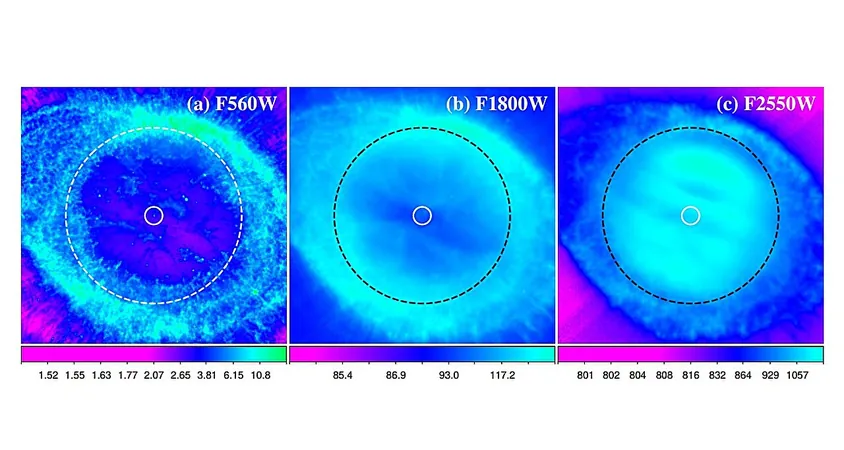
Stunning Discovery: JWST Unveils Dusty Disk Around the Central Star of the Ring Nebula
2025-04-09
Author: Yan
A Cosmic Revelation with the JWST
Astronomers using the James Webb Space Telescope (JWST) have made a groundbreaking discovery within the iconic Ring Nebula, also known as Messier 57 (NGC 6720). This extraordinary planetary nebula, located about 2,570 light-years away in the constellation Lyra, is now believed to host a dusty ring enveloping its central star.
Understanding Planetary Nebulae: The Star's Final Showdown
Planetary nebulae, the cosmic remnants of stars transitioning from their vibrant main-sequence phase to cooler white dwarfs, play a critical role in our understanding of stellar and galactic evolution. Though relatively rare, these beautiful celestial formations help astronomers unravel the mysteries of cosmic chemistry.
The Ring Nebula: A Celestial Icon
First discovered in 1779, the Ring Nebula is a classic example of a planetary nebula. With an elliptical shape and a radius of about 1.3 light-years, it's often considered a model for studying such phenomena. Its stunning visuals and impressive dynamics continue to capture the imaginations of astronomers and enthusiasts alike.
Revolutionary Techniques: JWST's Near-Infrared Insights
Led by Raghvendra Sahai from NASA's Jet Propulsion Laboratory, the research team utilized JWST's advanced Near-Infrared Camera (NIRCam) and Mid-Infrared Instrument (MIRI) to capture new images of the Ring Nebula. Their observations revealed unexpected excess emissions at wavelengths exceeding 5.0 micrometers, indicating the presence of a compact dust disk surrounding the star.
What Lies Within the Dust Cloud?
This newly discovered dust cloud spans approximately 2,600 astronomical units and consists primarily of tiny, amorphous silicate grains. Surprisingly, the total mass of this dust is estimated to be around 0.00000186 times that of Earth—an intriguing insight into the nebula's composition.
The Central Star: A Cosmic Dynamo
The central star of the Ring Nebula, on its journey to becoming a white dwarf, boasts a mass of about 0.61 solar masses and an impressive effective temperature of approximately 135,000 Kelvin. With a luminosity reaching 310 solar luminosities, it's clear that this stellar remnant is a formidable presence in our galaxy.
Surprising Variability and Cosmic Companionship
Interestingly, the study also observed significant variations in the star's brightness. This variability may stem from a close companion star—a faint main-sequence dwarf—indicating a complex evolutionary history that has shaped this nebula into its current form.
A Glimpse into Stellar Evolution
The research highlights that the surrounding dust cloud could be a remnant from a previous phase of binary interaction, hinting at the star's turbulent past before reaching its current state. This discovery not only enriches our understanding of the Ring Nebula but also deepens our insight into the life cycles of stars.


 Brasil (PT)
Brasil (PT)
 Canada (EN)
Canada (EN)
 Chile (ES)
Chile (ES)
 Česko (CS)
Česko (CS)
 대한민국 (KO)
대한민국 (KO)
 España (ES)
España (ES)
 France (FR)
France (FR)
 Hong Kong (EN)
Hong Kong (EN)
 Italia (IT)
Italia (IT)
 日本 (JA)
日本 (JA)
 Magyarország (HU)
Magyarország (HU)
 Norge (NO)
Norge (NO)
 Polska (PL)
Polska (PL)
 Schweiz (DE)
Schweiz (DE)
 Singapore (EN)
Singapore (EN)
 Sverige (SV)
Sverige (SV)
 Suomi (FI)
Suomi (FI)
 Türkiye (TR)
Türkiye (TR)
 الإمارات العربية المتحدة (AR)
الإمارات العربية المتحدة (AR)